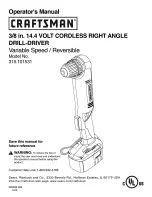
18
HKC 55 EB
GB
kerf causing excessive friction, blade binding and
kickback.
f.
Blade depth and bevel adjusting locking levers
must be tight and secure before making the cut.
If blade adjustment shifts while cutting, it may
cause binding and kickback.
g.
Use extra caution when sawing into existing
walls or other blind areas.
The protruding blade
may cut objects that can cause kickback.
Lower guard function
a.
Check the lower guard for proper closing before
each use. Do not operate the saw if the lower
guard does not move freely and close instantly.
Never clamp or tie the lower guard into the open
position.
If the saw is accidentally dropped, the
lower guard may be bent. Raise the lower guard
with the retracting handle and make sure it
moves freely and does not touch the blade or any
other part, in all angles and depths of cut.
b.
Check the operation of the lower guard spring.
If the guard and the spring are not operating
properly, they must be serviced before use.
Lower guard may operate sluggishly due to dam-
aged parts, gummy deposits, or a build-up of de-
bris.
c.
The lower guard may be retracted manually
only for special cuts such as "plunge cuts" and
"compound cuts". Raise the lower guard by the
retracting handle and as soon as the blade en-
ters the material, the lower guard must be re-
leased.
For all other sawing, the lower guard
should operate automatically.
d.
Always observe that the lower guard is covering
the blade before placing the saw down on bench
or floor.
An unprotected, coasting blade will
cause the saw to walk backwards, cutting what-
ever is in its path. Be aware of the time it takes for
the blade to stop after switch is released.
Function of the guide wedge [1-5]
a.
Use the correct saw blade for the guide wedge,
where possible. The function of the guide wedge
is restricted if using saw blades with a thicker
blade core.
To ensure that the guide wedge func-
tions properly, make sure the blade core of the
saw blade is thinner than the guide wedge and
that the tooth width is greater than the thickness
of the guide wedge. Expect increased risk of
kickback when using a thicker saw blade.
b.
Do not operate the saw if the guide wedge is
bent.
Even the slightest problem can cause the
guard to close more slowly.
Further safety instructions
–
This electric power tool cannot be installed in a
work bench.
The electric power tool may become
unsafe and cause serious accidents if installed in
benches from other manufacturers or self-man-
ufactured work benches.
–
Never reach into the chip ejector with your
hands.
Rotating parts may injure your hands.
–
Use suitable detectors to determine if utility
lines are hidden in the work area or call the lo-
cal utility company for assistance.
Contact with
electric lines can lead to fire and electric shock.
Damaging a gas line can lead to explosion. Pene-
trating a water line causes property damage or
may cause an electric shock.
–
Wait until the power tool stops completely until
placing it down.
The tool can become entangled
and lead to a loss of control of the power tool.
– Do not use the machine for overhead work.
–
Harmful/toxic dust may be produced during
your work (e.g. paint containing lead, certain
types of wood and metal).
Inhaling or coming
into contact with this dust may represent a haz-
ard for operating personnel or persons in the vi-
cinity. Comply with the safety regulations that
apply in your country.
Wear a P2 dust mask to protect your
health.
2.3
Residual risks
In spite of compliance with all relevant design reg-
ulations, hazzards while operating the machine still
occur e.g.:
– Touching the saw blade in the area of the front
opening below the saw table,
– Touching the parts of the saw blade that protrude
below the saw table while cutting,
– Touching rotating parts from left and right sides:
saw blade, clamping flange, flange screw.,
– Kickback of machine due to jamming in the
workpiece,
– Touching live parts when the casing is opened
and the mains plug is in the socket,
– the flying off of parts,
– the flying off of machine parts from a damaged
machine,
– noise emission,
– dust emission.
2.4
Aluminium processing
When sawing aluminium, the following mea-
sures must be taken for safety reasons:









































